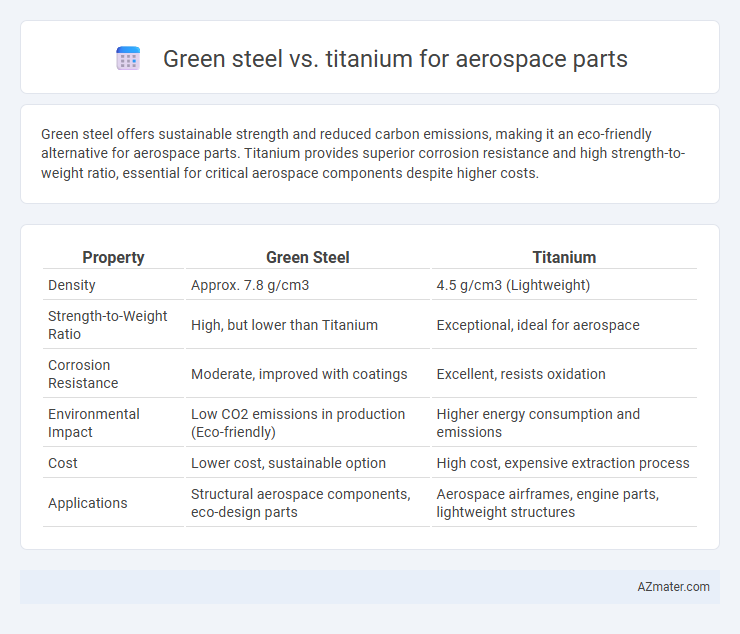Green steel offers sustainable strength and reduced carbon emissions, making it an eco-friendly alternative for aerospace parts. Titanium provides superior corrosion resistance and high strength-to-weight ratio, essential for critical aerospace components despite higher costs.
Table of Comparison
| Property | Green Steel | Titanium |
|---|---|---|
| Density | Approx. 7.8 g/cm3 | 4.5 g/cm3 (Lightweight) |
| Strength-to-Weight Ratio | High, but lower than Titanium | Exceptional, ideal for aerospace |
| Corrosion Resistance | Moderate, improved with coatings | Excellent, resists oxidation |
| Environmental Impact | Low CO2 emissions in production (Eco-friendly) | Higher energy consumption and emissions |
| Cost | Lower cost, sustainable option | High cost, expensive extraction process |
| Applications | Structural aerospace components, eco-design parts | Aerospace airframes, engine parts, lightweight structures |
Introduction to Aerospace Material Selection
Aerospace material selection prioritizes strength-to-weight ratio, corrosion resistance, and sustainability, where green steel and titanium present unique advantages. Green steel offers a reduced carbon footprint through eco-friendly production methods while maintaining commendable mechanical properties suitable for certain aerospace components. Titanium excels with superior strength, light weight, and exceptional corrosion resistance, making it a preferred choice for critical aerospace parts despite higher material and processing costs.
Overview of Green Steel Technology
Green steel technology uses renewable energy sources and hydrogen-based reduction processes to significantly reduce carbon emissions compared to traditional steel manufacturing. This sustainable approach emphasizes decarbonization by replacing coke and coal with green hydrogen, which produces water instead of CO2 as a byproduct. Its growing adoption in aerospace manufacturing offers a low-carbon alternative to titanium, balancing environmental impact with structural performance requirements.
Titanium in Aerospace: Properties and Applications
Titanium's high strength-to-weight ratio, corrosion resistance, and ability to withstand extreme temperatures make it a preferred material in aerospace components such as airframes, engines, and fasteners. Its density, approximately 4.5 g/cm3, is significantly lower than steel, contributing to fuel efficiency and performance optimization in aircraft design. The aerospace industry's increasing demand for lightweight and durable materials highlights titanium's critical role in advancing sustainable flight technologies.
Environmental Impact: Green Steel vs Titanium
Green steel, produced using hydrogen-based reduction methods, significantly lowers carbon emissions compared to traditional steel, making it a more sustainable choice for aerospace parts. Titanium's extraction and processing demand high energy consumption and generate substantial greenhouse gases, increasing its environmental footprint. Choosing green steel for aerospace components supports substantial carbon footprint reduction and aligns with the industry's shift toward eco-friendly materials.
Mechanical Performance Comparison
Green steel exhibits high tensile strength and excellent fatigue resistance, making it a competitive choice for aerospace structural components, while titanium is renowned for its superior strength-to-weight ratio and corrosion resistance. Titanium alloys outperform green steel in terms of specific strength (strength per unit density) and resilience at elevated temperatures, critical for aerospace applications requiring lightweight and thermal stability. However, green steel's lower cost and improved sustainability profile position it as a viable option where weight reduction is less critical than mechanical durability and environmental impact.
Weight and Efficiency Considerations
Green steel offers a significant environmental advantage with reduced carbon emissions but is generally heavier than titanium, impacting aerospace weight efficiency. Titanium's exceptional strength-to-weight ratio and corrosion resistance enhance fuel efficiency and performance in aerospace components. Weight optimization in aerospace favors titanium for critical parts, while green steel may be used where sustainability priorities outweigh minimal weight increases.
Cost Analysis: Production and Lifecycle
Green steel offers a cost advantage in production due to lower energy consumption and reduced carbon emission penalties compared to traditional steel, while titanium incurs high extraction and processing costs driven by complex refining and alloying steps. Lifecycle expenses for titanium include superior corrosion resistance and strength-to-weight ratio, reducing maintenance and fuel costs despite higher initial investment, whereas green steel's recyclability and growing market demand contribute to long-term economic sustainability. Evaluating aerospace part applications requires balancing green steel's affordability and eco-friendly benefits against titanium's performance-driven premium and lifecycle efficiency.
Corrosion Resistance and Durability
Green steel offers exceptional corrosion resistance due to its oxide layer stability and sustainability in manufacturing, making it ideal for aerospace components exposed to harsh environments. Titanium, renowned for its outstanding durability and natural corrosion resistance in extreme temperatures and saline conditions, remains a top choice for high-performance aerospace parts. Both materials enhance aerospace part longevity, but titanium's superior strength-to-weight ratio often outperforms green steel in critical aerospace applications.
Future Trends in Aerospace Material Innovation
Green steel, characterized by reduced carbon emissions during production, offers a sustainable alternative for aerospace parts while maintaining high strength and durability. Titanium remains favored for its exceptional strength-to-weight ratio and corrosion resistance, critical for aerospace applications demanding performance and reliability. Future trends in aerospace material innovation emphasize hybrid composites combining green steel's environmental benefits with titanium's mechanical advantages to optimize efficiency and sustainability.
Conclusion: Choosing the Right Material for Aerospace Parts
Selecting the right material for aerospace parts hinges on balancing performance, sustainability, and cost-effectiveness; green steel offers lower carbon emissions and high strength, making it ideal for reducing environmental impact without compromising durability. Titanium excels in lightweight properties, corrosion resistance, and exceptional strength-to-weight ratio, crucial for maximizing fuel efficiency and performance in critical aerospace components. Decision-makers should assess specific application requirements, environmental goals, and lifecycle costs to determine whether green steel or titanium best aligns with their engineering and sustainability objectives.

Infographic: Green steel vs Titanium for Aerospace part
 azmater.com
azmater.com